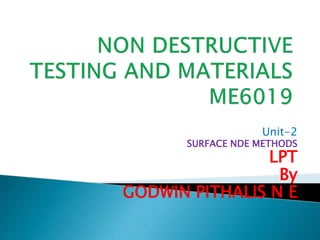
Ndtm unit-2-PPT
- 1. Unit-2 SURFACE NDE METHODS LPT By GODWIN PITHALIS N E
- 2. UNIT II SURFACE NDE METHODS Liquid Penetrant Testing - Principles, types and properties of liquid penetrants, developers, advantages and limitations of various methods, Testing Procedure, Interpretation of results. Magnetic Particle Testing- Theory of magnetism, inspection materials Magnetisation methods, Interpretation and evaluation of test indications, Principles and methods of demagnetization, Residual magnetism.
- 3. Introduction •Penetrant Testing, or PT, is a nondestructive testing method that builds on the principle of Visual Inspection. •PT increases the “seeability” of small discontinuities that the human eye might not be able to detect alone.
- 4. •In penetrant testing, a liquid with high surface wetting characteristics is applied to the surface of a component under test. •The penetrant “penetrates” into surface breaking discontinuities via capillary action and other mechanisms. •Excess penetrant is removed from the surface and a developer is applied to pull trapped penetrant back the surface. •With good inspection technique, visual indications of any discontinuities present become apparent.
- 5. 1. Pre-Cleaning or Surface Preparation 2. Penetrant Application 3. Excess Penetrant Removal 4. Developer Application 5. Examination, Interpretation and Evaluation 6. Post-process cleaning
- 6. Stages of LPT 1) Clean & Dry Component 4) Apply Developer 2) Apply Penetrant 3) Remove Excess 5) Examination, & Evaluation 6) Post Clean Component
- 7. •Parts must be free of dirt, rust, scale, oil, grease, etc. to perform a reliable inspection. •The cleaning process must remove contaminants from the surfaces of the part and defects, and must not plug any of the defects.
- 8. Many methods of application are possible such as: – Brushing – Spraying – Dipping/ Immersing – Flow-on – And more •Dwell Time •Sufficient time is allowed for the penetrant to enter any discontinuity open to the surface
- 10. The removal technique depends upon the type of penetrant used, as stated earlier… – Water Washable – Solvent Removable – Post Emulsifiable
- 11. •A coarse water spray is used to remove the excess penetrant. •The procedure used as a guideline for the inspection will specify water temperature (typically 50-100°F) and pressure (typically not more than 40 psi), etc.
- 12. •The part is wiped with a clean dry cloth to remove the bulk of the excess penetrant. •Then, a cloth lightly dampened with solvent is used to remove any remaining penetrant on the surface •Suitable flash time is required to allow excess solvent to evaporate
- 13. •When there is concern about removing much of the penetrant from the defect, a post emulsifiable system is used. •This involves an additional step in which an emulsifier is applied to the surface of the part after the penetrant dwell time. •The emulsifier is given just enough time to react with the penetrant on the surface to render it water washable but not enough time to diffuse into the penetrant trapped in the defects.
- 14. The method of developer application is dependent on the type of developer used. The primary methods – Dry – Wet – Nonaqueous Wet Dry Powder Developer: •Prior to applying a dry powder developer, the component must be thoroughly dried. Drying is usually accomplished in a hot air circulating oven. •The developer is then applied by immersing the part in the powder or by dusting of the part with the powder. •The part can also be placed in a developer dust cloud chamber.
- 15. •Wet developers are applied by immersing or spraying the part while it is still wet from the penetrant removal process. •The part is completely coated and the excess liquid allowed to drain to prevent pooling •The part is then dried in a hot air circulating oven.
- 16. •Nonaqueous developer is applied by a aerosol spray to a thoroughly dried and cooled part. •A thin even coating should be applied. The coating should be white but still slightly transparent when performing a visible dye penetrant inspection, and even thinner when performing a fluorescent penetrant inspection.
- 17. In this step the inspector evaluates the penetrant indications against specified accept/reject criteria and attempts to determine the origin of the indication. The indications are judged to be either relevant, non- relevant or false. A very important step of evaluation is to document findings on an inspection report form or other record keeping form. This may be supported with drawings or photos of indications, etc.
- 18. The final step in the penetrant inspection process is to thoroughly clean the part that has been tested to remove all penetrant processing materials. The residual materials could possibly affect the performance of the part or affect its visual appeal
